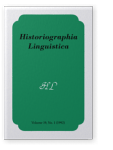La Particule Làkinna vue par un Grammairien Arabe du XIIIe Siècle
Ou Comment une Description de Détail S’inscrit Dans une ‘Théorie Pragmatique’
Cet article se veut une double contribution matérielle et méthodologique à une histoire bien comprise de la linguistique. Partant de la description, de nature pragmatique, donnée de la particule lākinna par le grammairien Radī l-dīn al-’Astarābāḏī (XIIIe siècle), nous montrons en 2 que, par le biais de l’interprétation qu’en propose ce grammairien (lākinna = ‘istadraktu, où ’istadraktu est un verbe à la lère personne), elle s’inscrit en fait dans le cadre d’une véritable théorie générale, elle-même de nature pragmatique, où fa’altu représente la formalisation d’un objet dont la catégorie de ’inšā (= “création”) constitue la conceptualisation. En 3, enfin, nous montrons que l’utilisation d’un texte ‘marqué’ par rapport à la grammaire arabe ‘moyenne’ permet non seulement de faire l’histoire de celle-ci, mais encore de représenter des nuances importantes entre groupes de grammairiens, voire d’un grammairien à l’autre.
Article language: French
References
A.Sources primaires
1001 Nuits = ‘Alf layla wa-layla
. 31 vols. Dār al-hilāl
1958.

BDIM
ŠA = Badr al-dīn Ibn Mālik dit Ibn al-Nāẓim.
Šarḥ ‘Alfiyyat Ibn Mālik Ed.
Abd al-Ḥamīd al-Sayyid Muḥammad ‘
Abd al-Ḥamīd Beyrouth Dār al-Ğīl, s.d.
Dasūqī
,
Ḥašiya = Muḥammad b. Muḥammad ‘Arafa al-Dasūqī.
Ḥašiya ‘alā l-Muḫtaṣar fī šarḥ Talḫīṣ al-Miftāḥ, dans Šurūḥ al-Talḫīṣ. 41 vols. Le Caire: Maṭba’at ‘Īsā al-Bābī al-Ḥalabī
1937.

Ğāmī
ŠΚ = Nūr al-dīn ‘Abd al-Raḥmān al-Ğāmī.
al-Fawā’id al-Ḍiyā’iyya fī šarḥ al-Kāfiya. Istanbul, 1310 H.
Ğurğānī
ḤŠK = ‘Alī b. Muḥammad al-Ğurğānī.
Ḥāšiya ‘alā šarḥ al-Raḍī. Cf. RDA,
ŠK.
Ğurğānī
,
Ta’rīfāt = Kitāb al-Ta’rīfāt Ed. Gustav Flügel. Leipzig: Vogel
1845 [Réimp., Beyrouth: Librairie du Liban 1978.]

IḤ
Κ = Ibn al-Ḥāğib. al-Kāfiyafī l-naḥw. Cf. RDA,
ŠK.
IḪ
,
Murtağal = Ibn al-Ḫaššāb. al-Murtağal fī šarḥ al-Ğumal Ed. ‘
Alī Haydar. Damas: Manšūrāt Dār al-Ḥikma
1972.

IHA
,
ML = Ibn Hišām al-’Anṣārī. Mugnī l-labīb fī kutub al-‘A’ārīb Ed. Māzin Mubārak et
Muḥammad ‘Alī Ḥamd Allāh. 2ème éd, 21 vols. Damas: Dār al-fikr
1969.

IHA
,
ŠŠḎ = Šarḥ Šuḏūr al-ḏahab fī ma’rifat kalām al-‘Arab Ed. Muḥammad Muḥyī l-din ‘Abd al-Ḥamīd/person-group>. 5ème éd. Le Caire
1371/1951.

IHA
,
ŠQN = Šarḥ Qaṭr al-nadā wa-ball al-ṣadā Ed. Muḥammad Muḥyī l-din ‘Abd al-Ḥamīd. 11ème éd. Le Caire
1383/1963.

IM
,
Τ = Ibn Mālik. Tashīl al-fawā’id wa-takmīl al-maqāṣid Ed. Muḥammad Kāmil Barakāt. Le Caire: Dar al-kātib al-‘arabī li-l-ṭibā’a wal-našr
1387/1967.

IY
ŠM = Ibn Ya’īš. Šarḥ al-Mufaṣṣal. 101 vols. Le Caire: ‘Idārat al-ṭibā’a al-munīriyya, s.d.
Muḥarram Effendi
Ḥāšiya ‘alā šarḥ Ğāmī ‘alā l-Kāfiya. 21 vols. Istanbul. 1308 H.
RDA
ŠK = Raḍī l-dīn al-‘Astārābādī. Šarḥ al-Kāfiya. 21 vols. Istanbul: Maṭba’at al-šarika al-ṣiḥāfiyya al-‘uṯmāniyya. 1275 et 1310 H. [Réimp., Beyrouth: Dār al-kutub al-‘ilmiyya, s.d.]
S
MU = al-Sakkākī. Miftāḥ al-‘ulūm. Le Caire: Maṭba’at al-taqqadum al-‘ilmiyya. 1348 H. [Réimp., Beyrouth: Dār al-kutub al-‘ilmiyya, s.d.]
Z
M = al-Zamaḫšarī. al-Mufaṣṣal. Le Caire, 1323 H. [Réimp., Beyrouth: Dār al-Ğīl, s.d.]
B.Sources secondaires
Anscombre, Jean-Claude
1985 “
Onomatopées, délocutivité et autres blablas”.
Revue romane 20:2.169–207.

Austin, John Langshaw
1962 How to Do Things with Words. London: Oxford Univ. Press. [Traduction française,
Quand dire, c’est faire (Paris: Le Seuil 1970).]

Benveniste, Émile
1969 “
Sémiologie de la langue”.
Semiotica 11.1–12 et 21.127–135.


Berrendonner, Alain
1981 Eléments de pragmatique linguistique. Paris: Minuit.

Belot, Jean-Baptiste
1896 Dictionnaire al-Faraed Arabe-Français. Beyrouth: Imprimerie catholique.

Brockelmann, Carl
1943–49 Geschichte der arabischen Literatur. 2ème éd. Leiden: E. J. Brill.

Chomsky, Noam
1965 Aspects of the Theory of Syntax. Cambridge, Mass.: MIT Press. [Traduction française,
Aspects de la théorie syntaxique (Paris: Le Seuil 1971).]

Ducrot, Oswald
1972 Dire et ne pas dire. Paris: Hermann.

Ducrot, Oswald
1977 “
Illocutoire et performatif”.
Linguistique et sémiologie 41.17–53. Lyon: Presses Universitaires de Lyon.

Ducrot, Oswald et al.
1980 Les mots du discours. Paris: Minuit.

Heidegger, Martin
1970[1916] Traité des catégories et de la signification chez Duns Scot. Traduit de l’allemand et présenté par
Florent Gaboriau. Paris: Gallimard.

Larcher, Pierre
1980 Information et performance en science arabo-islami-que du langage. Thèse pour le doctorat de 3e cycle, Univ. de Paris III. [Compte rendu par
E. Brejon dans
L’Arabisant 22/231.64–70. Paris: Association Française des Arabisants 1984.]

Larcher, Pierre
1988 “
Quand, en arabe, on parlait de l’arabe … I: Essai sur la méthodologie de l’histoire des ‘métalangages arabes’”.
Arabica 35:2.117–142.


Larcher, Pierre
1991a “
Du mais français au lākin(na) arabe et retour. Fragment d’une histoire comparée de la linguistique”.
Revue Québécoise de linguistique 20:1.171–93.


Larcher, Pierre
1991b “
Quand, en arabe, on parlait de l’arabe … II: Essai sur la catégorie de ‘inšā’ vs ḫabar
”.
Arabica 38:2.246–73.


Larcher, Pierre
à paraître. “
Quand, en arabe, on parlait de l’arabe … III: Grammaire, logique, rhétorique dans l’islam post-classique”. A paraître dans
Arabica
.
Morris, Charles W.
1938 “
Foundations of the Theory of Signs”.
International Encyclopaedia of Unified Science 1:2. Chicago: Univ. of Chicago Press. [Traduction française partielle, “
Fondements de la théorie des signes”,
Langages 351.15–21 (Paris: Larousse 1974).]

Quine, Willard V. O.
1973 Méthodes de logique. Paris: Armand Colin. [Traduction française de l’original américain,
Methods of Logic
, 3e éd. (
Holt, Rinehart &
Winston 1972).]

Wright, William
1896–98 A Grammar of the Arabic Language. 3e éd. Cambridge: Cambridge Univ. Press.

Cited by
Cited by 3 other publications
This list is based on CrossRef data as of 30 april 2024. Please note that it may not be complete. Sources presented here have been supplied by the respective publishers.
Any errors therein should be reported to them.
